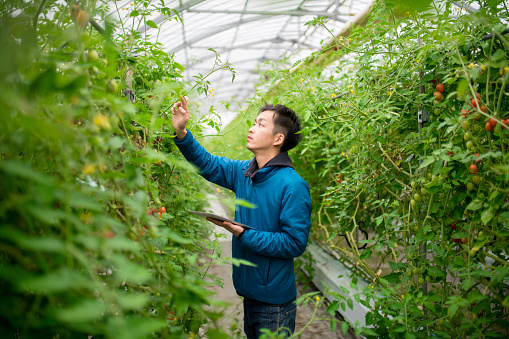How Technology is Transforming Agriculture Economics
For decades, technology in agriculture economics farmers has tried to find ways to remain profitable in an ever-changing agriculture economy. From the rise of new competitors to changes in consumer tastes and government policies, the challenges posed to farmers continue to evolve.
Agriculture is becoming a more just and sustainable industry, but it will require innovating and changing with the times. That’s why the agricultural technology industry is booming.
These days, it seems like every week brings news of a new agricultural technology that is changing how we farm. Artificial intelligence and advanced data analysis are giving rise to new machine learning technologies that are revolutionizing the way farmers operate and make informed business decisions.
However, while agriculture is seeing a lot of change, farmers are still the backbone of the industry. As such, agricultural technology innovations will require a different set of solutions to really make a difference.
This article will explore the ways in which agriculture is being transformed by advanced technologies, both positive and negative. We’ll also explore the ways in which technology is giving rise to new agricultural economics, which are further transforming the industry.
Advanced Technologies
Nearly two-thirds of all new agricultural technology is developed to improve productivity, one quarter to improve the environment, and only 9% of new tech is developed to address food safety or security concerns.
The productivity-enhancing technologies focus on increasing crop yields per acre by using better cultivation methods, more advanced genetics, or improved inputs like increased fertilizer and water usage. As yields go up, so does the income of the farmers who adopt these technologies.
The environment-enhancing technologies tackle issues like soil erosion, water pollution, and greenhouse gas emissions. These issues have negative effects on both the environment and human health, so technologies that mitigate these issues are seen as positive steps forward.
Finally, the food safety and security technologies focus on issues like food-borne illnesses and the use of unapproved pesticides. Food-borne illnesses are a major issue for both consumers and the agricultural industry. The more knowledge that is available to farmers about how to prevent and identify such illnesses, the better equipped the industry will be to maintain public trust.
Automation
Automation is altering the way farmers operate across all sectors of agriculture. The equipment used on farms is becoming more automated, with fewer manual operations and human oversight. As a result, productivity has gone up and operational costs have gone down.
These days, it is not uncommon to see a field completely unmanned, with autonomous machines doing the work of farmers. Combine this technology with remote monitoring and machine learning, and you have the potential to vastly improve agricultural productivity while reducing costs and labor.
Artificial Intelligence and Machine Learning
Artificial intelligence and machine learning are giving rise to machine perception in agriculture. This technology uses data analysis to give machines the ability to perceive and make decisions.
For example, it is now possible to use data to teach a machine to recognize patterns and predict outcomes. This has led to the development of programmable machines that can be taught to improve with each use.
Machine perception is being applied to more than just machine learning. Increasingly, it is being used to give machines a “sensing,” “feeling,” or “perceiving” capability. This can be used to create digital “sentinels” that can monitor and analyze environmental conditions, or it can be used to give machines a “mind’s eye” view of the world, allowing them to perceive and respond to changes in the environment as well as predict outcomes.
Precision Farming
Precision farming is all about identifying the specific needs of individual farms and translating that knowledge into specific recommendations. This can be as simple as recommending the use of specific seeds or fertilizer, or it can be focused on the application of specific pesticides or even the type of water needed.
At the heart of precision farming is the use of data to recommend specific actions. This requires the use of sensors to collect data, either on individual plots of land or across an entire field.
Data analysis can then be used to identify commonalities between different fields, such as growing seasons, rainfall, or soil types. This allows for the application of more tailored recommendations for specific farmers, such as those focused on water usage.
However, while precision farming has been around for a while, it is only now that the industry is seeing the rise of next-generation precision farming solutions. These combine artificial intelligence with data analysis to give even more specific recommendations based on the needs of individual farms.
Connected Farmers
The final emerging trend in agriculture is the rise of the “connected farmer.”
The connected farmer is a far cry from the days of manually entering data into a spreadsheet or manually entering data into a database. Now, farmers are becoming “internet-of-things” enabled, with sensors collecting data and sending it to the cloud for analysis and visualizations.
This data can be used to give connected farmers a real-time view of the state of their fields, equipment performance, and the state of their weather. It can also be used to give them timely alerts about issues such as water pollution or excessive frost damage.
In many ways, the connected farmer is a future-facing farmer, ready to take advantage of emerging technologies and make informed business decisions.
Read More: Tips to Improve Your Life When You’re Being Economic Stonewalled
Internet of Things (IoT)
The Internet of Things is transforming the way that we interact with our machines and with our environment.
The IoT is enabling the connection of machines and devices through communication networks. This allows for a greater degree of automation and the sharing of data.
For instance, a rain gauge connected to a weather station can send data regarding rainfall to a farmer’s smartphone, allowing him or her to make informed decisions about when to irrigate.
The ability to collect and analyze data in real-time makes the IoT a powerful tool for both monitoring and managing machines and the environment.
Augmented Reality (AR) and Virtual Reality (VR)
Augmented reality and virtual reality are both experiencing massive growth on farms. The ability to combine the real world with computer-generated imagery allows for a much more immersive experience for both farmers and consumers.
For example, AR can be used to give instructions on how to use a piece of new technology, or it can be used to give instructions on how to plant or harvest a field. AR can also be used to provide real-time weather updates.
VR can be used to give farmers a more realistic view of their fields and the state of their equipment. This can be used to provide training for new technologies, or it can be used to give farmers a more realistic view of how their fields will look following the application of new technologies.
Blockchain in Agriculture
Blockchain is a technology that has drawn a lot of attention in the media in recent years. However, while the technology is exciting, it is still in its infancy in agriculture.
While it has been used in financial services for years, it has only recently been applied to agriculture as a way to improve transparency and traceability in the food system.
One of the most commonly discussed uses of blockchain in agriculture is related to food safety. The use of blockchain to track food from the farm to the table has been proposed as a way to address concerns over the safety of imported food.
However, while promising, blockchain has a long way to go before being implemented in the agriculture industry. Currently, there is a lack of standardization and a lack of implementation.
That said, given the speed at which technology is advancing, it is likely that we will begin to see more progress in this area in the near future.
Summary
The agricultural industry is seeing a lot of change, with emerging technologies transforming the way that farmers operate and make informed business decisions.










